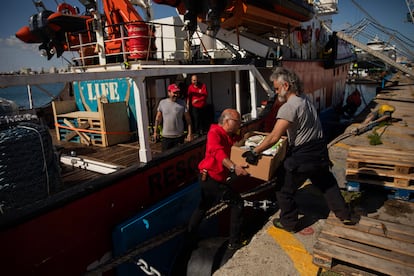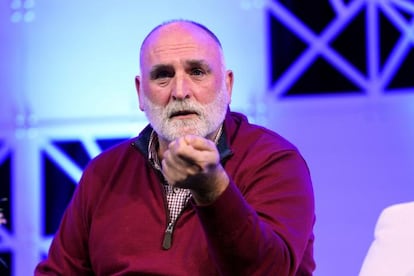Operation Safeena: The thousand and one obstacles to bringing aid to Gaza by sea
Chef José Andrés, who led the effort, explains how the mission to take 200 tons of food by sea with the Spanish ship ‘Open Arms’ was made possible with help from Cyprus, Jordan and UAE

The Open Arms, a ship operated by a Spanish charity of the same name that normally conducts rescue operations at sea, departed on Tuesday morning from the port of Larnaca in Cyprus, inaugurating a maritime corridor to bring aid to Gaza, where a desperate humanitarian situation has been unfolding since the Hamas attacks of October 7 in Israel.
The mission, named Operation Safeena (which means boat in Arabic), is highly complex due to the challenges that have arisen since it began to take shape over two months ago. “I had no doubt that we could open the maritime route. The most difficult thing was the diplomatic side of it, and the easiest thing was getting to Gaza,” reveals its main promoter, Spanish-American chef José Andrés, founder of the non-profit World Central Kitchen (WCK), in a telephone conversation. The celebrity chef insists that nothing should be taken for granted and that there are still multiple variables that could make the mission fail, including those of a technical and logistical nature.
However, even if the maritime corridor is successfully created, allowing for a sustained flow of humanitarian aid ships, this is not the most effective way to bring relief to the Gaza Strip, where international agencies are warning about acute malnutrition. Opening the land crossings that Israel has blocked would be more efficient, if compared to the amount of aid that a ship like the Open Arms can carry, with the amount of supplies that used to enter by land before the blockade.
Weight and volume is what determines the load a truck can carry. The maximum weight allowed in one of the tractor-trailers that move around the Gaza border is 20 tons, according to logistics experts who regularly work with shipments. Thus, the 200 tons of food carried by the Open Arms is equivalent to 10 trucks. The flow of trucks into the Gaza Strip before the war was about 500 a day. Right now, with hundreds of thousands of displaced people and famine on the rise, even that amount would not be enough to meet the needs of the 2.3 million people in Gaza.
The diplomatic work to get a shipment to Gaza by sea has been carried out by José Andrés himself, who is also a sports and nutrition advisor to the White House. For two months he held countless meetings in Israel, Egypt and Jordan to obtain the necessary permits, mainly from COGAT — an agency of the Israeli Defense Ministry that manages the civil affairs of Gaza and the West Bank — and the Palestinian Authority. He also obtained support from the government of Cyprus, King Abdullah II of Jordan and the United Arab Emirates, which has co-financed the mission together with WCK.

While the diplomatic issues were being ironed out, the technical aspects brought problems of their own. One of the first questions was how to move the 200 tons of aid, since the Open Arms — a rescue vessel with a length of 37m (121ft) and a beam of 10m (33ft) — does not have that kind of capacity. The solution came in the shape of a barge 20m (65ft) long by 10m (33ft) wide. The barge, tied to the ship with steel cables, was loaded with 200 tons of non-perishable food, including canned tuna, flour, rice and legumes, distributed on 130 pallets. Gerard Canals, operations coordinator for Open Arms, explains that although the cargo has been arranged in a way that guarantees stability, the waves will affect it much more than they will affect the ship. “It is a square in the middle of the sea and is not designed to navigate long distances, and especially not in bad weather, but the Open Arms is a tugboat, it is specially designed for this task,” he says.
The weather has indeed been another challenge. It was the reason why the ship’s departure, initially scheduled for last Saturday, was delayed. The condition was that the waves could not exceed one and a half meters in height, according to Canals. The Open Arms departed when it was determined that the weather conditions were going to be suitable to make the journey without losing the cargo. “Even so, you have to go very slowly because this barge is not a device designed to navigate fast, it is simply to carry cargo in still-water areas, near the port, near the coast...,” warns the coordinator. Therefore, it is sailing at an average speed of three knots, or in other words, three times slower than its usual cruising speed. Considering that Gaza is about 280 miles from Cyprus, the mission will not reach its destination for at least three days.
Another problem was how to unload the aid in Gaza when there are no working ports left. For this reason, WCK has been building a jetty for weeks with rubble and the remains of bombed buildings and with some cranes and construction machines that still work. Its location has not been disclosed for security reasons.
About 25 people attached to the Spanish charity have been working on construction of the jetty. To access the site, they must obtain prior permission from the Israeli authorities, who have cordoned off the area. “The sand, the tide, the wind, the machines, the permits, having enough fuel for the cranes and tractors, having enough cement…,” lists José Andrés, asked about the difficulties they are encountering there. “This is still a pilot program. Once we have a jetty, the idea is to build a bigger one.”
To get permission to unload the cargo, the project had to get creative, because the unmovable condition that Israel imposed was that the crew must not maintain any contact with the population of Gaza. For this reason, the Open Arms’s two semi-rigid boats will push the barge to the jetty, where WCK personnel will be waiting to tie it up and unload the pallets with the help of the machines they have there. Then, the pallets will be placed inside trucks, which will deliver them to the 60 kitchens that the NGO has set up in the Gaza Strip, and to other aid distribution points.
A real solution
The problem of Israel’s blockade of humanitarian aid to Gaza is not a logistical issue, but a political one, acknowledge sources from humanitarian organizations working in the enclave who prefer to remain anonymous. They explain that they do not have a specific list from Israel that specifies which materials are not authorized for access. This lack of information, together with the arbitrariness of the decisions, complicates the entry flow.
Israeli authorities have put up all kinds of obstacles to the entry of equipment and items that are necessary to confront the humanitarian crisis in the Gaza Strip, as different organizations and the Palestinian authorities themselves have repeatedly denounced. After waiting up to a month at the gates of the enclave for a shipment to be admitted, if the Israeli inspection detects a single object that it does not consider suitable, all the material is sent back to Egypt, said the Palestinian Ministry of Health, dependent on Hamas.
“Without an official list of restricted objects, Doctors Without Borders (MSF) reports that it has been repeatedly prohibited from importing electricity generators, water purifiers, solar panels and other medical equipment,” warns the Ministry of Health. The ban on these materials can make the difference between “life and death” for thousands of patients, among whom there are some with chronic diseases such as cancer, diabetes or epilepsy. MSF sources add the specific case of oxygen concentrators to help the sick breathe.
The Strip has seven border crossings, six with Israel and one with Egypt, of which only the latter and one with Israeli territory are partially open. The arrival of aid through these points by truck is faster, cheaper and more accessible than by sea or by air, as is the case with aid dropped by parachute from airplanes.
Sign up for our weekly newsletter to get more English-language news coverage from EL PAÍS USA Edition
Tu suscripción se está usando en otro dispositivo
¿Quieres añadir otro usuario a tu suscripción?
Si continúas leyendo en este dispositivo, no se podrá leer en el otro.
FlechaTu suscripción se está usando en otro dispositivo y solo puedes acceder a EL PAÍS desde un dispositivo a la vez.
Si quieres compartir tu cuenta, cambia tu suscripción a la modalidad Premium, así podrás añadir otro usuario. Cada uno accederá con su propia cuenta de email, lo que os permitirá personalizar vuestra experiencia en EL PAÍS.
¿Tienes una suscripción de empresa? Accede aquí para contratar más cuentas.
En el caso de no saber quién está usando tu cuenta, te recomendamos cambiar tu contraseña aquí.
Si decides continuar compartiendo tu cuenta, este mensaje se mostrará en tu dispositivo y en el de la otra persona que está usando tu cuenta de forma indefinida, afectando a tu experiencia de lectura. Puedes consultar aquí los términos y condiciones de la suscripción digital.
More information
Archived In
Últimas noticias
Maduro to be tried in the US for narcoterrorism and corruption
Maps of the US attack on Venezuela: Targets, airspace and deployed fleet
Venezuelans in exile: ‘This could be the end of a very dark chapter for Venezuela, but also the beginning of a time of uncertainty’
Key points of the military attack on Venezuela: Early morning bombings and a ‘captured’ president
Most viewed
- Alain Aspect, Nobel laureate in physics: ‘Einstein was so smart that he would have had to recognize quantum entanglement’
- David King, chemist: ‘There are scientists studying how to cool the planet; nobody should stop these experiments from happening’
- Mexico completes its trade shift with the entry into force of tariffs on China and countries without trade agreements
- Reinhard Genzel, Nobel laureate in physics: ‘One-minute videos will never give you the truth’
- Oona Chaplin: ‘I told James Cameron that I was living in a treehouse and starting a permaculture project with a friend’









































